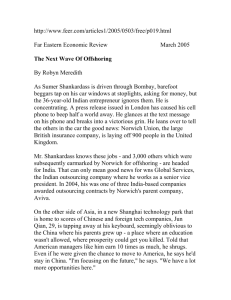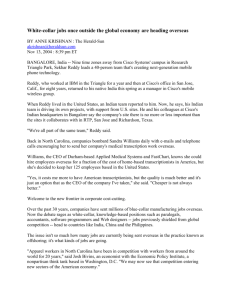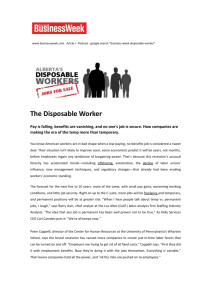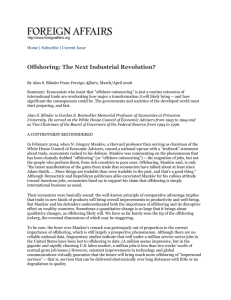Background Information - American Bar Association
advertisement
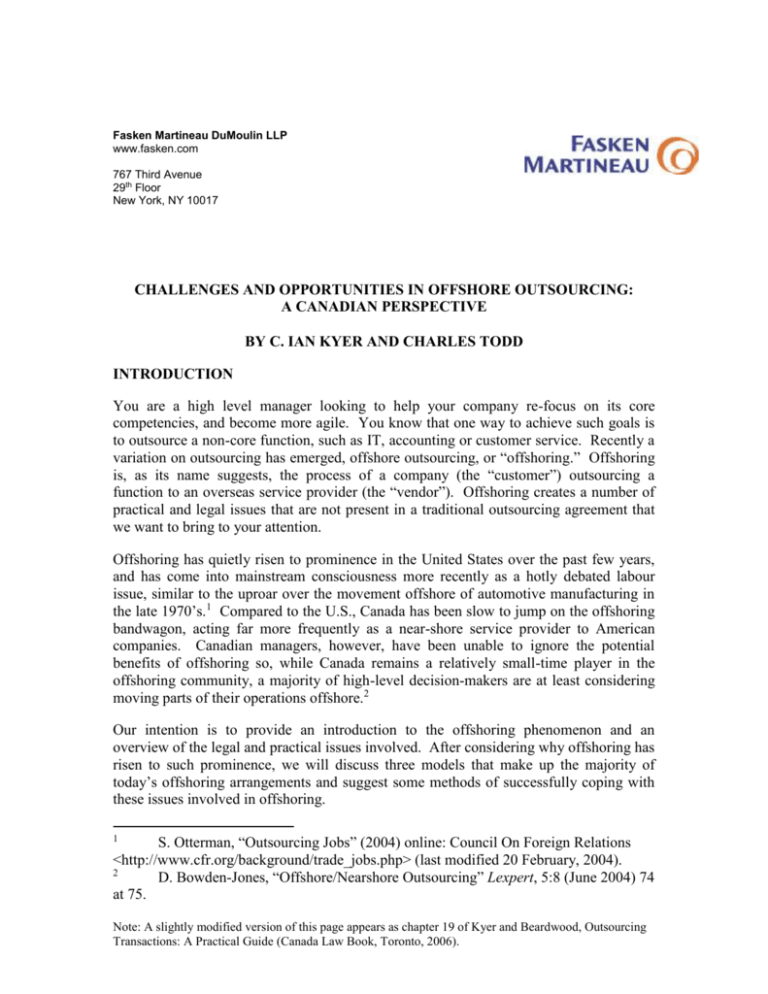
Fasken Martineau DuMoulin LLP www.fasken.com 767 Third Avenue 29th Floor New York, NY 10017 CHALLENGES AND OPPORTUNITIES IN OFFSHORE OUTSOURCING: A CANADIAN PERSPECTIVE BY C. IAN KYER AND CHARLES TODD INTRODUCTION You are a high level manager looking to help your company re-focus on its core competencies, and become more agile. You know that one way to achieve such goals is to outsource a non-core function, such as IT, accounting or customer service. Recently a variation on outsourcing has emerged, offshore outsourcing, or “offshoring.” Offshoring is, as its name suggests, the process of a company (the “customer”) outsourcing a function to an overseas service provider (the “vendor”). Offshoring creates a number of practical and legal issues that are not present in a traditional outsourcing agreement that we want to bring to your attention. Offshoring has quietly risen to prominence in the United States over the past few years, and has come into mainstream consciousness more recently as a hotly debated labour issue, similar to the uproar over the movement offshore of automotive manufacturing in the late 1970’s.1 Compared to the U.S., Canada has been slow to jump on the offshoring bandwagon, acting far more frequently as a near-shore service provider to American companies. Canadian managers, however, have been unable to ignore the potential benefits of offshoring so, while Canada remains a relatively small-time player in the offshoring community, a majority of high-level decision-makers are at least considering moving parts of their operations offshore.2 Our intention is to provide an introduction to the offshoring phenomenon and an overview of the legal and practical issues involved. After considering why offshoring has risen to such prominence, we will discuss three models that make up the majority of today’s offshoring arrangements and suggest some methods of successfully coping with these issues involved in offshoring. 1 S. Otterman, “Outsourcing Jobs” (2004) online: Council On Foreign Relations <http://www.cfr.org/background/trade_jobs.php> (last modified 20 February, 2004). 2 D. Bowden-Jones, “Offshore/Nearshore Outsourcing” Lexpert, 5:8 (June 2004) 74 at 75. Note: A slightly modified version of this page appears as chapter 19 of Kyer and Beardwood, Outsourcing Transactions: A Practical Guide (Canada Law Book, Toronto, 2006). WHY CONSIDER OFFSHORING? There is no doubt that the principal factor motivating offshoring is the differential between North American and Asian labour costs. Managers may cite other benefits, but without the significantly lower labour costs offshoring would not even enter the realm of consideration. It is estimated that labour costs in India for a competent and well qualified IT employee can be as little as 15% of the cost of a comparable employee in America, and the costs in China are even less.3 The Indian government is also very committed to expanding and solidifying the IT sector, as demonstrated by the elimination of various impediments to exporting, and by the implementation of numerous tax incentives that make doing business there very attractive.4 Of course, there are many other costs and risks that need to be considered before going ahead with an offshoring agreement. For example, a Gartner study stated that only 21.1% of companies actually reported cost savings of more than 20% from offshoring, and 18.4% of companies surveyed reported absolutely no savings at all.5 The reasons for such shortcomings will be addressed later, but with such low labour costs, the total savings of implementing a successful offshoring project can be considerable. While the promise of labour cost savings is a necessary condition for the popularity of offshoring, there are a number of other factors that are also driving the evolution. Increased quality of service heads that list. Even with lower labour costs, value for money is still of utmost concern to today’s managers, so if service levels were to stagnate or fall below domestic levels, the value of offshoring would be compromised and the trend would likely fizzle out. The reason offshoring has so much momentum is that wellimplemented projects can result in significant increases in the quality of the service at substantially lower cost. India’s top IT firms, for example, have attained the leading standard in software quality methodologies, a benchmark many North American firms have yet to reach.6 Also, Indian vendor companies are among the most desirable employers in the country, which means they have the pick of the best and brightest employees.7 Although the wage paid to educated, highly-skilled Indian employees is a small fraction of that paid to their North American counterparts,8 the standard of living enjoyed by the Indian employees of vendor companies is extremely high, so the employees are more than satisfied to work at those pay levels. The result is competent, motivated employees who produce a quality of service that may go beyond the North American service that was replaced. India has other advantages – as a former British colony, there is widespread use of English, a 3 D. Barrett, Successful Offshore Outsourcing (London: Direct Publications Limited, 2004). 4 Thakker & Thakker, “India – Destination Outsource” Mumbai. 5 “A new paradigm in IT: Outsourcing” online: IBM Canada <http://www1.ibm.com/businesscenter/ca/resources/featurearticle.jsp?contentId=9265>. 6 R. Scott, T Garner & D Tocoll, A Fine Balance (Toronto: PricewaterhouseCoopers, 2004) at 4. 7 Ibid. 8 Barrett, supra note 3, at 11. modern legal system and a general level of familiarization with Western cultural and business sentimentalities. Although India remains culturally distinct, the foundations laid by the British in language, education and law make it a very attractive offshoring destination. China, which is fast becoming another of the world’s leading offshoring vendor countries, lags behind India in a number of ways. The comparably weak infrastructure, the sparse presence of English language skills, and the significant cultural differences with the West means that China is lacking in many areas important to the offshoring industry, such as security, reliability and qualification levels. However, with a population of over 1.3 billion, it is only a matter of time before China’s outsourcing providers begin to catch up to their Indian competitors.9 The other traditional reasons for outsourcing, such as flexibility, agility, access to cuttingedge resources not economically feasible internally, and an enhanced ability to focus on core business functions, generally still exist in offshoring agreements, but with a few caveats. There is no doubt offshoring can give companies an enhanced ability to focus on core business functions and can result in increased access to resources, but gaining increased flexibility and agility will depend on how the deal is structured and on the ability of management to overcome the unique challenges of offshoring. POSSIBLE SCENARIOS FOR OFFSHORING Most of today’s offshoring agreements follow two general scenarios, a customer outsourcing a service directly to a third party vendor overseas or a customer outsourcing a service to the domestic office of a global vendor, which may have a subsidiary overseas that undertakes the task or may subcontract the task out to a third party vendor overseas. A third option may be to create your own subsidiary overseas, which then undertakes the task somewhat autonomously.10 Each scenario has its own unique benefits, costs and risks that must be weighed before a customer decides which option is best suited to its project. For convenience, we will assume that the customer in each scenario has already gone through the initial stages of any outsourcing project, namely assessing the value of the function to be outsourced and the feasibility and risk of the project, and has decided to pursue some form of outsourcing. The first and second scenarios will almost always involve the customer issuing a Request for Proposals (RFP) to potential vendors. Sometimes firms are approached by vendors, or a customer may retain a consultant to help select a vendor, but generally significant offshoring agreements begin with an RFP. The reason for the prominence of RFPs in offshoring projects is simply that it is an efficient and effective way to find the vendor best suited to provide the function. An RFP solicits responses from a number of vendors all seeking to provide the same function, so the customer can evaluate the market in a somewhat controlled manner and with a measure of consistency. The proposals can be 9 10 Bowden-Jones , supra note 2, at 78. Scott, supra, note 6, at 24. weighed against each other, and against the existing in-house function, on the basis of cost and level of service, among other factors. 1. Outsourcing Directly to a Third Party Vendor Overseas In the current age of globalization, it is less likely that a customer will outsource directly to an overseas vendor, as many are establishing offices in North America to better facilitate such agreements, but the basic structure of the project remains a domestic company outsourcing to an offshore firm. This scenario may seem to be the lowest-cost form of offshoring but there may be significantly higher transaction costs and greater risk than the second scenario. Still, the potential for considerable cost-savings over both of the other scenarios does exist, if the agreement allocates the risk appropriately and the implementation of the project is well managed. After the RFP stage, the customer must carefully survey the options they have received and decide whether offshoring is indeed the best course of action to take. At this stage, managers will need to be cognizant of all the issues involved in this type of offshoring project in order to make a sound decision. Those issues include the following: (a) Contractual Issues Offshoring agreements have to address all the problems of any outsourcing project, such as cost controls, project management issues or service level assurances, but now those things have to be dealt with across borders. Thus an offshoring agreement will necessarily be more complex than one for a domestic outsourcing. Jurisdictional issues will have to be addressed, such as which system of law governs the contract, if it is the vendor’s system, does foreign law in any way restrict or negate the enforceability of rights under the contract, or are remedies affected by foreign laws? An agreement that saves millions of dollars on paper is worthless if it cannot be enforced effectively, and this will be the case if customers do not take into account the difficulties of creating a contract that can bind a vendor overseas. The expensive world of international litigation is one that must be avoided if offshoring is to be successful. (b) Regulatory Issues There are three aspects to offshoring: the service must be moved out of the domestic country, it must be transferred into the foreign destination, and then it must be provided from that destination. The first entails a transfer of data and goods out of the domestic jurisdiction, and a lay-off of employees, so any domestic laws and restrictions on such transfers or layoffs need to be considered. In terms of setting up the service overseas, managers need to be aware of any licences or permits that will be required in the foreign jurisdiction, or any conditions, such as local ownership requirements, that may have to be met before the function can be provided. The ongoing provision of the service will be subject to both domestic and foreign regulation, the extent of which will depend upon the nature of the service. If extensive data management is involved, for example, the offshore operation may be subject to the laws of both the customer’s and vendor’s domestic data protection laws as well as international treaties. If the customer happens to be in a more heavily regulated industry there will be more specific and extensive regulations that must be adhered to when offshoring a function. The Canadian financial services industry, for example, is subject to the “Outsourcing of Business Activities, Functions and Processes” guidelines, which are enforced by the Office of the Superintendent of Financial Institutions. Those guidelines constitute the baseline supervisory and risk-management practices for Canadian financial firms or branches to outsource functions.11 Regulatory issues, whether they are for all companies or industry specific, can easily transform a seemingly profitable offshoring agreement into a costly and burdensome venture if they are not adequately addressed early in the life of the project. (c) Privacy Issues The nature of offshoring agreements requires that a substantial amount of data will likely have to be transferred to the service provider, the quantity dependant on the type of service to be performed. Customer firms may be surprised that, according to the Personal Information Protection and Electronic Documents Act (“PIPEDA”), Canada’s privacy laws still apply if they send data overseas to a third party to be processed.12 Customers must ensure that, once data has been transferred to an offshore location, the information is still afforded the same level of protection that it would be domestically. The local laws may be of little value because either they do not exist or they are not enforced, so it becomes the customer’s responsibility to enforce levels of protection equal to those provided by Canadian law while data is in the possession of the vendor. If any kind of extensive data management is involved, a project can easily be compromised by failing to consider privacy issues from the outset. (d) Intellectual Property Issues Many offshoring projects may also require the transfer or creation of unique software or processes, which raises the issue of how to protect them. Vendor countries often suffer from a lack of IP protection compared to Canada, which could result in that software being misused and the benefits of the project being diminished significantly. This situation exists despite the fact that the major offshore vendor countries are signatories to the WTO-based TRIPS (trade-related aspects of intellectual property rights) agreement. TRIPS is meant to establish minimum levels of protection that each government has to give to the IP of fellow WTO members,13 but that protection may not be sufficient for 11 R. McDowell et al., “New Outsourcing Expectations of the Office of the Superintendent of Financial Institutions” January 2004 Fasken Martineau Financial Institutions and Services Bulletin. 12 Personal Information Protection and Electronic Documents Act 2000 c. 5 Schedule 1, Principle 4.1.3. 13 “Intellectual property: protection and enforcement” online: World Trade Organization <http://www.wto.org/english/thewto_e/whatis_e/tif_e/agrm7_e.htm>. offshoring agreements. First of all, the level of protection established by the TRIPS agreement is far below Canadian levels of IP protection and secondly, the fact that a country has agreed to TRIPS in no way guarantees that those levels of protection will be enforced. (e) Cultural Differences Some managers, especially early in the offshoring boom, saw the huge potential savings from the gap in labour costs and jumped head first into offshoring agreements without considering implications of the stark cultural differences between Eastern and Western societies. Once they became involved in a long-term offshoring agreement, they experienced those differences first hand and the result was often a rocky, sometimes short-lived relationship. One difference, for example, is that the Indian business community is much more family-oriented than that in North America. Traditionally, before Indians conduct business with people with whom they are not familiar, they will socialize for a time, and get to know and trust the prospective associates. Only then will they proceed to the negotiation stage of a transaction. Westerners may find this peculiar and disconcerting, and an unprepared reaction can result in the prospective business partner being very insulted. Another example of a difference between Indian and North American employees is that Indian employees often need much more direction than North American or European employees, relying much more heavily on their management team then we are accustomed to.14 If the customer is aware of such differences the managerial style can be adjusted accordingly, but without the prior knowledge such idiosyncrasies can be very disruptive. Bear in mind that India is probably the country that is most familiar with the Western business community, so the cultural differences between North American firms and those in China will be even greater. Of course, the more common offshoring becomes, the more accustomed to dealing with Westerners vendor countries will become, and vice versa. However, today there are still substantial differences between East and West in the way business is conducted and a major failing of many offshoring agreements is that those differences are neither predicted nor planned for. (f) Disruption to Domestic Employees Many offshoring agreements run into difficulty because of the atmosphere created in the domestic office. Employees who are unsure of their situation and their future will tend to be far less productive and less supportive of what they may see as a threatening development. All offshoring projects require the assistance of at least some of the existing employees to successfully transfer a function, and if those employees or their colleagues are unhappy then the project could be compromised. They may see success of the offshoring project as a negative rather than a positive. Managers must ensure the culture of their domestic firm can sustain offshoring without too much disruption; they must maintain the trust of their employees, those remaining and those departing, by being 14 M. Kobayashi-Hillary, “Why we’re all going to India” The Observer (4 April 2004) online: Guardian unlimited <http://observer.guardian.co.uk/business/story/0,6903,1185056,00.html>. open and honest throughout the entire process. Normal outsourcing agreements can be extremely unsettling to existing employees, even though they usually involve only transfers of employment, rather than the terminations that inevitably come with offshoring, so the source of the increased disruption is obvious. Offshoring does cost real people their jobs domestically, and managers who are not sympathetic to that throughout every stage of the project can compromise its success. Aside from the effects on the lives of the employees who lose their jobs, other pitfalls with respect to domestic employees can include employment regulations and also the presence of unions. Terminating employees can be an expensive and complicated proposition, especially if unions are involved. Notice requirements, severance settlements, and the legal ability to actually terminate contracts can quickly erode the prospective savings of an offshoring project. The applicable Employment Standards Act must be strictly observed when employees are terminated, and the rigid enforcement policies that often apply to union contracts must also be considered. An offshoring agreement may look great on paper, but if managers fail to plan for the disruptions and pitfalls involved with existing domestic employees, the deal can quickly lose its lustre. (g) Other Issues Offshoring has also become a prominent political issue recently, especially in the U.S. The trend gained widespread recognition when it was praised by the chief economic advisor to George W. Bush, N. Gregory Mankiw, as “a good thing” in the annual Economic Report of the President.15 Since that time, the issue has been hotly debated because of the thousands of domestic jobs being moved overseas. The Democrats have taken a stand staunchly opposing offshoring, giving a voice to the thousands who are jobless, or could potentially become unemployed, due to the upswing in offshoring. There have been a plethora of state and federal bills introduced recently that will have the effect of making it much more difficult for American companies to offshore, such as laws forcing call centre employees to identify their location or requiring government contracts to be completed in the U.S., but few have been passed into law. 16 Unions in the United Kingdom have also come out against offshoring and are taking measures to impede its progress. For example, Lloyds TSB Group Union was recently behind a request for the Information Commissioner Richard Thomas to rule on whether the practice of transferring confidential customer information to Indian processing centres without a customer’s express consent is in breach of their Data Protection Act. 17 If the Commissioner does find a breach, British companies will be forced to seek consent to offshore customer’s confidential data and consequently publicize the fact they are outsourcing British jobs to India, which the Union hopes will affect business enough to override the benefits of offshoring. The debate is similar to that of the late 1970’s, when 15 Otterman, supra, note 1. S. Klinger &L Sykes, “Alston + Bird Legislative and Public Policy Advisory” (10 May 2004). 17 “Complaint over data transfer to India”, Out-Law.com (19 August 2004) online: <http://www.outlaw.com/php/page.php?page_id=complaintoverdata1092930444&area=news> 16 thousands of jobs, particularly in the auto industry, were being shipped to locations with drastically lower labour costs. However, today’s offshoring situation is significantly different. The jobs lost in the current offshoring wave are primarily knowledge-based, versus the labour-intensive jobs replaced during the shift in the auto industry, and as communications technology moves forward, anything that can be digitized will become susceptible to offshoring. The result is that the jobs lost to offshoring are harder to replace at the same level as labour-based jobs, if they can be replaced at all. Ironically, the massive amount of press coverage that the debate has recently garnered has opened the eyes of many managers and generated a significant buzz about the low cost and high quality that offshoring can provide. One Indian manager speculated that the industry has received hundreds of millions of dollars of free advertising in the last six to nine months alone.18 From a very different perspective, the offshoring boom has also had a significant impact on Indian society. Thomas Friedman, a columnist for the New York Times, investigated that impact in a Discovery Channel documentary entitled “The Other Side of Outsourcing”, with surprising results. India, an ancient culture steeped in tradition, has undergone drastic changes since the beginning of the offshoring boom in the 1990’s, most notably among the younger generation. While their parents’ generation may have experienced frequent exposure to Western culture through the British presence, movies and television, it was usually viewed as a far away dream world, which simply did not exist in India. For the three million IT employees in India today, their new-found wealth has brought that Western-style, capitalistic dream world home. The cost of living in India is about one-fifth of that in America, which means that while salaries are substantially less than those in North America, a job in a call centre can vault a young Indian into the upper echelons of the middle class. With disposable income comes the rampant consumerism of the West, and the Indian youth that are involved in offshoring seem to be fully embracing it. Not everyone touched by offshoring is happy with its effects though, as many elders and more traditional Indians are concerned that the recent Westernization is eroding Indian culture. There is no doubt that things are rapidly changing, and the boom shows no sign of letting up from the supply side. For example, Infosys, a leading Indian offshoring provider, had over a million applicants for only 9,000 call centre jobs last year, a reminder of the size of the job pool in India where 54% of the Indian population is under the age of twenty-five.19 So, is India better off now that it is becoming more integrated into the global market? If you ask a young call centre employee, you will get a resounding “Yes”, but the response from the older generation may be much different, as it surely will be from the millions of Indians still living in deplorable, third-world conditions just feet from the lavish, Western-style office complexes. The boom in offshoring to India has created thousands of jobs at extremely attractive salary levels, but a lesser known fact is that, because of competition for experienced 18 J. Solomon, “Trend toward sending work to India is accelerating”, The Globe and Mail (28 June, 2004) B8. 19 “Thomas Friedman Reporting: The Other Side of Outsourcing” Discovery Channel Productions. employees among Indian IT firms and also significant emigration to North America by those employees, the rate of attrition in the Indian IT sector is above normal.20 The service provided by the vendor may suffer as a result of those high attrition rates, as the vendor must frequently be utilizing less experienced employees and expending more resources training. The value of the project may also be affected, as the vendor is forced to spend more on training, with much of that investment lost if employees are leaving the company before the full value of that training has been realized. If customers fail to ensure that the vendor has the ability to retain its employees, the offshoring project can be severely compromised. There are a number of other issues to consider when deciding whether, and how, to undertake an offshoring project, such as auditing standards, local political concerns, currency fluctuation, tax issues, unforeseen transaction costs, enforcement of (rather than existence of) foreign laws, disaster recovery responsibilities, and/or long-term viability of vendor companies. Offshoring directly to a foreign vendor is a very complicated endeavour and can carry with it significant risk, but the potential rewards are considerable. In the final section, we will discuss some strategies to cope with these aforementioned issues, mitigate these risks and work towards realizing the full potential of offshoring. 2. Outsourcing a Service to the Domestic Office of a Global Vendor This scenario entails outsourcing a function to the domestic office of a global vendor firm, such as IBM or EDS, which then either provides the service from one of its offshore offices or contracts with a third party vendor offshore to provide the service. This model involves significantly less risk than the first, but consequently does not have the potential to deliver the same scale of rewards. IBM, for example, does not send any data management offshore, only software and application development. Its customers are then secure in the knowledge that, while part of their outsourcing may be completed offshore, their data will remain securely in Canada, but they will also pay a premium for that security. The pressure of crafting the initial agreement is diminished for the customer in this scenario because the offshoring portion is taken care of by the global firm, so it would generally be responsible for many of the issues discussed above. That is not to say it eliminates all of those issues, only that it minimizes many of them. At some point in the process all the issues involved in a normal offshoring project will have to be addressed, but which party deals with those issues will depend on how the agreement is structured. The customer will still have to deal with the impact of the agreement on domestic employees, as the vast majority of those involved in providing the in-house service will cease to be the customers’ employees. There may also be some of the cultural issues when the customer has to interact directly with the service provider offshore, but the likelihood of this arising is slim. The benefit of this scenario of offshoring is the increased certainty that comes with having an established partner like IBM and undertaking what basically amounts to a normal outsourcing agreement, but the 20 S. Mathias, “Key Issues in Outsourcing to India” The Computer Law Association Bulletin 18:3 (2003) 95 at 96. cost of implementing such a project will be substantially more than the first scenario, and some of the risks of offshoring may still be present to some degree. This scenario is not to be confused with outsourcing a function to the domestic satellite office of a firm located primarily overseas. In such agreements, the vendor will likely not have many assets in Canada, so customers will generally require a parental guarantee before entering into an offshoring agreement. That guarantee will essentially transform the project into one analogous with that described in the first scenario, and therefore eliminate most of the “global vendor” advantages. 3. Establishing a Wholly-Owned Subsidiary Overseas This scenario is not actually considered offshore outsourcing, because the firm is keeping the operation in-house, but it is an alternative to offshoring and does share some of the issues. A company will benefit from the lower labour costs offshore under this model, but the costs of establishing and managing the operation will reduce those savings, especially in the short to medium term. Establishing a new company in a foreign country is not an inexpensive proposition. In addition to cultural and proximity issues, a company will still have to deal with all the operational and procedural burdens that they did in their home country, and those burdens are likely to increase significantly because the operation would be in a jurisdiction that managers are not familiar with. The possible advantage of this scenario is that the company maintains full control over the process, while still benefiting from the lower wages and possibly increased quality of offshoring. Also, many of the privacy and IP issues of offshoring are eliminated because the company maintains full ownership and control of their data and systems, though they still must abide by and are only protected by the local laws. The disadvantages of this scenario abound. For example, the company actually loses flexibility and agility under this model because, rather than eliminating the disadvantages of carrying out the function in-house, those disadvantages are actually magnified by the increased difficulties of managing and implementing the function thousands of miles away. The costs of establishing the operation will be enormous, and may only be overcome by the savings of the cheaper labour in the long run, if at all. Basically, this scenario comes with many of the risks of offshoring, in addition to a much larger initial investment and all the inherent risks of running a business overseas, and it fails to deliver anywhere close to the same level of rewards. There is also a real risk that the foreign country’s labour market will mature to the point where the savings no longer outweigh the disadvantages of completing the task overseas, a risk present in almost all long term agreements. Still, this scenario may be appropriate for a company seeking to lower the labour costs of a certain function in the long term while still maintaining intimate control over every aspect of it, but there are probably much more attractive options available. Planning for a Successful Offshoring Project As it is no doubt clear by now, implementing an offshoring project is a risky proposition that involves many issues. There are strategies for overcoming those issues and mitigating the risks, which should increase the chances of such projects being successful and rewarding. (a) Choosing Counsel The first step in any offshoring project is retaining competent advisors including legal counsel, both domestically and in the jurisdiction from which the service will be provided. When choosing domestic legal representation, bear the following in mind: counsel should have extensive experience with outsourcing, familiarity with international transactions, and should have your confidence and trust. The third quality may be the most important, as a lawyer will not be an asset to any transaction if you do not feel comfortable with him or her, even if he or she has extensive offshoring experience. Consultation with legal counsel in the foreign jurisdiction throughout the offshoring project is essential to its success. When choosing foreign legal representation, there are a few key characteristics that can make the difference between a smooth transaction and one that the customer will regret. Communication skills, particularly in English, are high on that list. A successful offshoring agreement is dependant on the relationship between customer and vendor, and without clear communication with the foreign counsel that relationship will be hard to establish and maintain. Foreign legal representation must also be knowledgeable, not only in local laws and business norms, but also in the laws and practices of the North American business community. The purpose of an offshoring agreement is to improve the domestic business, and if the foreign counsel is not familiar with the needs and goals of the customer then their advice is unlikely to further those goals. In crafting an offshoring agreement there must be consultation with competent, experienced domestic and foreign legal counsel throughout the entire negotiation and implementation process in order to mitigate the many risks of offshoring. Many companies also seek the advice of independent consulting agencies from the early stages of an offshoring project. Given the offshoring experience that many of the large consulting firms have this strategy could be very useful, but managers must be aware of any vested interests that such advisors may have in seeking the completion of offshoring deals. Independence, impartiality and the willingness to abandon a deal if it is not in the best interests of the customer are all essential if a consulting firm is to be used.21 (b) Due Diligence Before finalizing the choice of a vendor company and going ahead with an offshoring project, the customer must ensure it has undertaken due diligence. In the context of offshoring that entails not only knowing the vendor, but also knowing the laws and culture of the vendor country. With respect to knowing the vendor, the customer should do a detailed background check of the company. Areas to focus on include the vendor’s financial situation, the state of the vendor’s previous and existing business relationships, its ability to retain employees, any litigation history, including the reasons for and outcome of that litigation, or any other legal issues that the company may have encountered, such as fines or sanctions. References should also be sought from the vendor and investigated, and the facilities where the service will be provided from should be visited before an offshoring agreement is finalized. 21 “Outsourcing: The Real Deal” 2003 Gartner, Inc. In terms of knowing the laws and culture of the vendor country, customers should be aware of any political issues that could affect the provision of the service, whether local or national. The customer should also be cognizant of the vendor country’s economic climate, so they are not surprised by a sudden downturn in the local economy, which could adversely affect the vendor and consequently the service provided. Local counsel will be indispensable in familiarizing the customer with the applicable laws of the vendor country, which is why competent local representation must be retained very early in the offshoring process. Knowing the culture of the vendor country, such as religious, social or business norms, will make the entire offshoring process go much more smoothly. Offshoring is heavily relationship-based, so the sooner you get to know your service provider well, the greater the chances are for a successful offshoring project. (c) Drafting the Agreement Once legal representation has been retained, the drafting of a sound initial agreement is the next step on the way to a successful offshoring project. A well-planned and carefully drafted contract can anticipate and allocate risks and provide mechanisms to avoid costly disputes. Offshoring projects are generally long-term and relationship-based, so a flexible agreement that balances the interests of the customer and vendor is key to maintaining the viability of the relationship, and consequently of the project.22 Generally, a successful offshoring agreement will contain built-in dispute resolution mechanisms which escalate from the relationship manager who will solve minor operational issues, to more complex remedies if disputes cannot easily be resolved. Again, offshoring agreements are long-term relationships and both the customer and the vendor have much to gain by maintaining the health of those relationships. That means avoiding the costly and extremely risky litigation of an international agreement. Such litigation involves tremendous uncertainty because of the conflict of laws governing the agreement, problems with enforcement in foreign jurisdictions, and general reliability of the legal systems in some vendor countries. In any case, parties to international agreements generally prefer arbitration to litigation, as they can choose who will preside over it, it is far less costly than traditional transnational litigation, and under the New York Convention23 awards are easier to enforce. The initial transfer of the service out of the domestic country, bringing the service into the foreign jurisdiction, and the ongoing provision of the service from the foreign jurisdiction all need to be considered and addressed. The first step requires domestic counsel with expertise in exporting data, goods and personnel. The second step requires consultation with local foreign counsel that is aware of the restrictions and regulations pertinent to bringing all the aspects of the service into the vendor country, and setting 22 C. Wright, “Avoiding the Pitfalls in Multi-jurisdictional Outsourcing” International Business Lawyer 32:1 (February 2004) 18 at 33. 23 United Nations Convention on the Recognition and Enforcement of Foreign Arbitral Awards, June 10, 1958, 330 U.N.T.S. 38, 21 UST 2517, TIAS 6687. This Convention has been adopted by the Province of Ontario in the International Commercial Arbitration Act, R.S.O. 1990, c. I.9. them up. The third step requires the co-operation of both domestic and foreign counsel to cope with the multi-jurisdictional issues of providing the service to the customer from the offshore jurisdiction. Planning is the key to addressing the regulatory issues of each stage of an offshoring project. Due to the substantial differences that may exist between domestic laws and those of the vendor country, an offshoring agreement may look very different than a normal outsourcing contract. With respect to issues such as IP protection and privacy concerns, clauses that many domestic agreements would simply assume because they are provided by law will need to be included in an offshoring agreement to ensure that they are observed. Generally, an agreement should include the highest privacy and IP protections that are provided by the laws in the customer country, repeated verbatim in the offshoring agreement, so the vendor is bound by them even though they are not local law. Dealing with privacy specifically, PIPEDA dictates that Canadian companies are responsible for personal information in their custody, even if that data is processed by a third party. Customer companies are required through “contractual or other means to provide a comparable level of protection while the information is being processed by a third party.”24 So, customer companies must ensure that Canadian levels of protection are built into their offshoring agreements in order to transfer that responsibility to the vendor, and also to have some legal recourse if the data are compromised. The risk of the customer’s data and IP being compromised is substantial when dealing in a country that does not offer the high standards of legal protection that North American countries do. Such protection must consequently be provided for within the agreement itself, through careful planning and, again, in consultation with foreign and domestic counsel, in order to mitigate those risks. A successful offshoring agreement will take the differences in culture and business style between the customer and vendor countries into account very early in the project. Preliminary and ongoing research, planning and preparation for those differences and considering all those involved in the project will ensure that interactions between the companies will be smooth and rewarding. Showing respect by accommodating the cultural differences, through such initiatives as cultural sensitivity training or frequent travel to the vendor country, can go a long way towards establishing a successful working relationship. Compromise can be key to successful offshoring agreements, so making an effort to acknowledge and accommodate some of the differences in culture can go a long way to establishing and maintaining the health of those relationships. (d) Enforcing the Agreement Enforcement of the agreement is another contractual issue that must not be overlooked. Obtaining an award of damages will do no good if there are no assets available to be seized or if there are restrictions on taking money out of the jurisdiction. To deal with the fact that the vendor is offshore, customers should consider adopting risk management mechanisms such as disruption of service insurance, or letters of credit. Customers could 24 Personal Information Protection and Electronic Documents Act 2000 c. 5 Schedule 1, Principle 4.1.3. also require that vendors maintain certain levels of assets in Canada, in escrow, or in the form of a domestic bank account to better facilitate compensation if performance problems arise. (e) Coping with Domestic Employees Addressing the disruptions to domestic employees during an offshoring project can also go a long way towards ensuring a smooth and successful agreement. Honesty throughout the entire project is key to minimizing the disruption that outsourcing a function overseas will undoubtedly cause to domestic employees. People will lose their jobs if a company decides to undertake an offshoring project, so fairness dictates that those employees are dealt with openly throughout. If this is the case, those employees who remain with the organization are also much more likely to assist in the implementation of the project. Some domestic employees will be required at various stages of an offshoring project, and if they are unsure of their status they are much more likely to be unhelpful and even damaging, so managers must deal with them honestly at every stage to mitigate those disruptions. Managers will also have to plan well in advance for the dismissal of domestic employees, considering existing contractual relationships, regulations in the governing Employment Standards Act, and any other constraints, such as unions, that may exist. Dismissing employees is almost always an expensive and complicated process, even without unions, but when they are involved, legally terminating a contract can sometimes be very difficult or impossible. Managers must consider all the costs involved in terminating employment contracts when they are assessing the prospective savings of an offshoring project. If such issues are unforeseen, they can quickly turn a profitable endeavour into an expensive and wasteful one; once again, planning is the key to success. CONCLUSION As a high level manager today, it is impossible to ignore the potential rewards of offshoring, such as substantially lower costs, improved quality, agility and flexibility, and the ability to re-focus on core competencies. However, as every successful manager knows, there is no silver bullet in the business world and every great opportunity carries with it significant risks that can materialize to cause serious problems. Offshoring is no different, but with careful planning at every stage of the project, in conjunction with experienced domestic and foreign counsel, offshoring can be a worthwhile and even lucrative endeavour.


